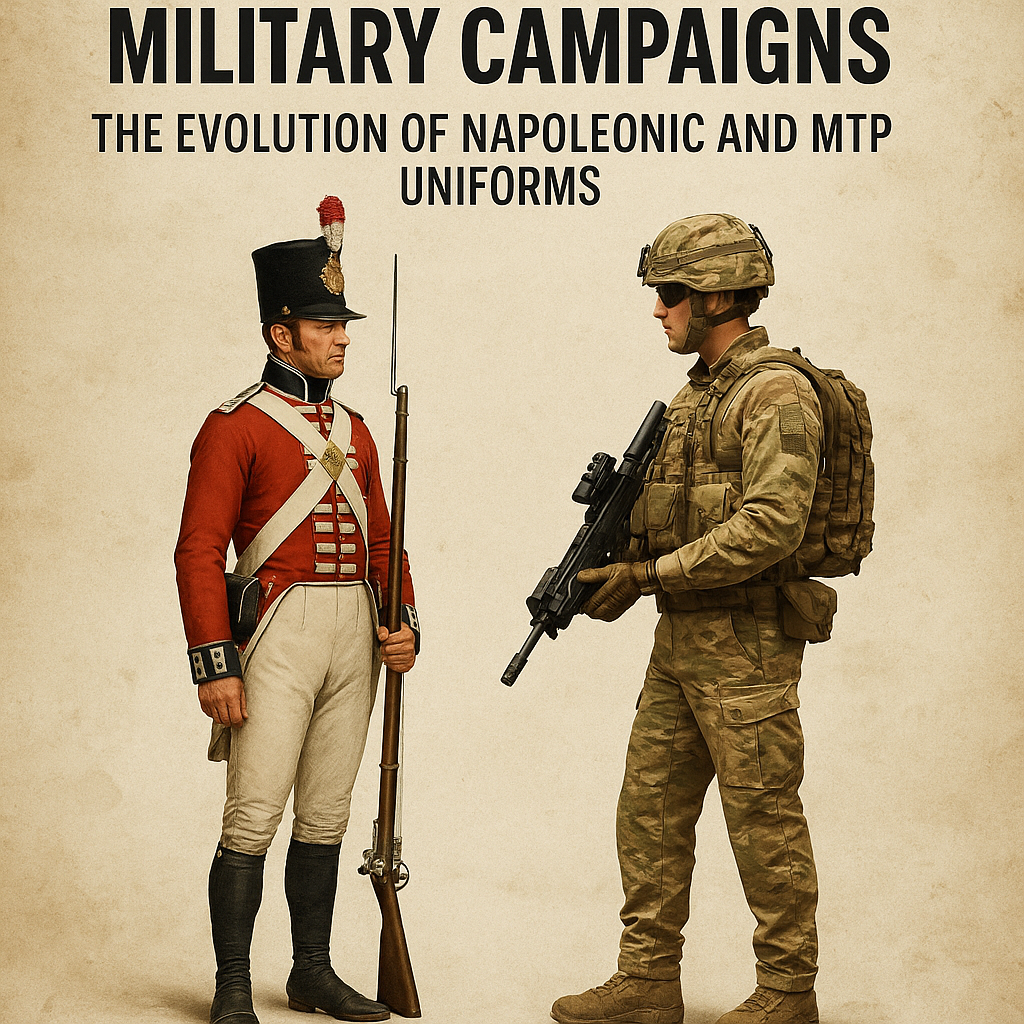
Historic British Military Campaigns: The Evolution of Napoleonic and MTP Uniforms
Published on May 21, 2025
Historic British Military Campaigns and the Evolution of Soldier Uniforms
From the scarlet-coated regiments of the Napoleonic Wars to the modern Multi-Terrain Pattern (MTP) used in contemporary missions, British military uniforms have become a symbol of authority, identity, and historical legacy. These uniforms reflect the periods they belong to and the tactics, technology, and terrain that shaped each military campaign. In this article, we take you on a journey through time, examining how British uniforms have evolved across pivotal historical campaigns.
1. The Napoleonic Wars: Scarlet and Strategy
The Napoleonic Wars (1803–1815) marked one of the most defining chapters in WW1 British military history. The iconic red coat became synonymous with British infantry, earning them the nickname “Redcoats.”
Napoleonic Wars British Uniforms were practical for line formations and battlefield identification. Soldiers wore red wool jackets, white cross belts, and shakos (military hats) adorned with regimental insignia. Officers often had gold braiding and fine tailoring to signify rank and status.
Key Uniform Features (Early 1800s):
- Color: Bright red coats with blue or white facings.
- Material: Wool, chosen for durability and warmth.
- Headgear: Shakos, often with plumes or brass plates.
- Accessories: Cartridge boxes, bayonets, and flintlock muskets.
Uniforms from this era are some of the most popular among collectors and re-enactors. If you're looking for a British soldier costume or Napoleonic British uniform replica, these designs are historically rich and visually striking.
2. British Uniforms of the 1800s: Beyond Napoleon
After the fall of Napoleon, British soldiers continued to participate in global conflicts, including in colonial India, the Crimean War (1853–1856), and the Anglo-Zulu War (1879). Each campaign demanded specific changes in uniform due to differing climates and combat needs.
Key Developments in British Uniforms 1800s:
- Tunic Adjustments: Gradual shift from red to khaki in later decades for better camouflage.
- Helmet Innovations: Transition from shakos to pith helmets in tropical climates.
- Battle Gear: Introduction of backpacks, mess tins, and water canteens as standard issue.
The mid to late 1800s saw experimentation with fabrics and colors, ultimately moving toward practicality over pageantry. While redcoats remained a ceremonial symbol, active duty uniforms became more subdued and mission-oriented.
3. 20th Century Wars and Uniform Modernization
World War I and II saw radical changes in how British soldiers dressed. Trench warfare and mechanized combat made earlier uniforms obsolete.
Key 20th Century Shifts:
- Camouflage Introduced: Earth-toned khakis became the standard.
- Helmet Modernization: Brodie helmet replaced earlier headgear for better protection.
- Layering: Uniforms designed to accommodate trench coats, gas masks, and wool underlayers.
By mid-century, uniforms began incorporating advanced stitching, better fabric blends, and modular components. While far removed from the elegance of Napoleonic styles, modern uniforms prioritized function and soldier safety.
4. British MTP: The Modern Battlefield Standard
The British Army's Multi-Terrain Pattern (MTP) uniform was introduced in 2010 as a response to the operational needs of troops serving in Afghanistan and Iraq. Designed to blend in with varied environments—from deserts to woodlands—MTP combines the most effective elements of previous camouflage patterns.
What Sets British MTP Apart:
- Adaptive Camouflage: Merges the best of Disruptive Pattern Material (DPM) and MultiCam.
- Material Composition: Lightweight, breathable, and moisture-wicking fabric.
- Design Features: Velcro-fastened pockets, rank insignia slots, and reinforced elbows/knees.
Modern British MTP uniforms are the epitome of today’s military apparel: agile, efficient, and grounded in real-world functionality. While they lack the flair of historical uniforms, their design is a product of strategic innovation.
5. Why Uniforms Matter in Historical Campaigns
Uniforms are more than clothing—they’re symbols of national identity, rank, tradition, and tactical strategy. They served not only to unite soldiers but to distinguish friend from foe in the chaos of battle.
Cultural Significance:
- Historical Reenactments: Enthusiasts recreate famous battles, relying on accurate British army costume reproductions.
- Film & Theater: Authentic British soldier costumes add credibility to historical dramas.
- Educational Value: Museums and history classes use replica uniforms to immerse students in the past.
From the grandeur of Napoleonic redcoats to today’s digital camo, these garments continue to tell the story of the British Army’s long and storied past.
6. Choosing the Right British Soldier Costume for Reenactment or Display
If you're a collector, historical enthusiast, or reenactor, selecting the right uniform involves more than aesthetics. Consider the campaign, time period, and the role of the soldier.
Popular Costume Choices Available at Paddelaters.com:
- Napoleonic British Uniforms: Perfect for 19th-century reenactments and educational demonstrations.
- British Uniforms 1800s: Great for portraying colonial-era soldiers or Victorian expeditions.
- Modern British MTP Sets: Ideal for contemporary military displays or tactical simulations.
Quality replicas can bridge the gap between history and hands-on engagement, offering a tangible connection to the past.
Conclusion: Preserving History Through Uniforms
From the thundering charge of redcoats at Waterloo to modern peacekeeping missions in MTP, British military uniforms are deeply woven into the fabric of world history. Whether you're exploring the strategic brilliance of historical campaigns or searching for the perfect British soldier costume, understanding the evolution of these uniforms brings new appreciation to the men and women who wore them.
Explore a range of historically accurate costumes and modern uniform sets at Paddelaters.com — where history is stitched into every seam.
